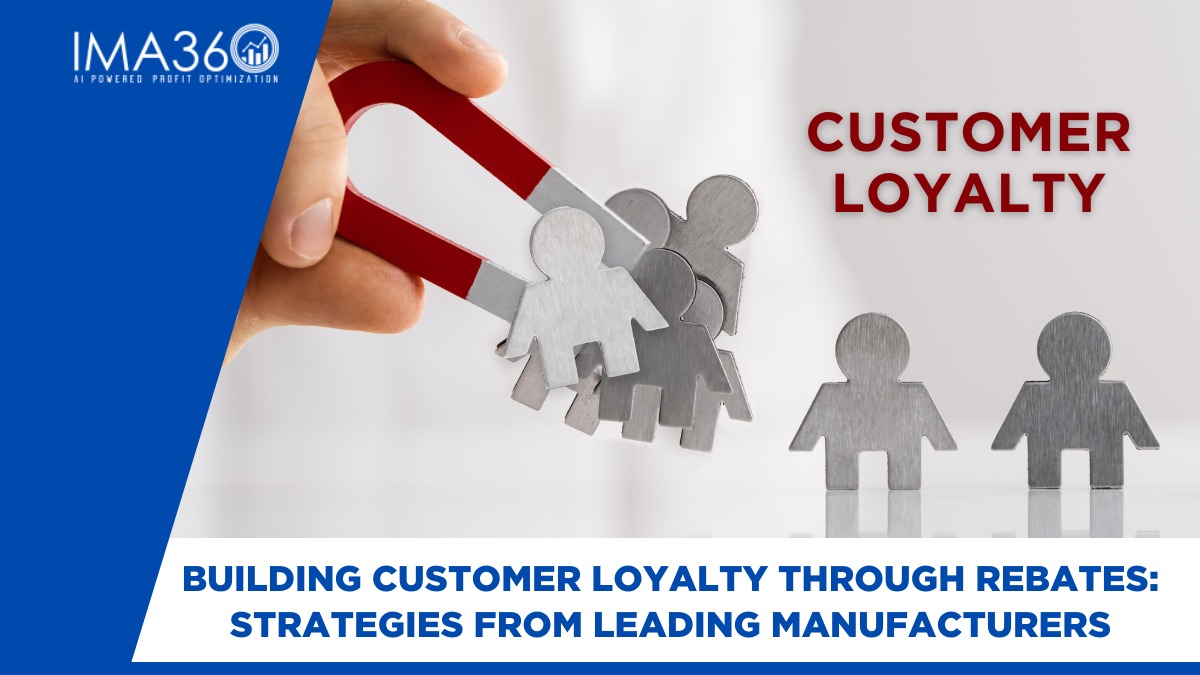Rebates can be defined as a means of increasing sales without lowering the agreed-upon price. To increase market share and growth, the distributor and supplier agree to these financial incentives based on real sales. Rebates are generally an incentive or reward for loyalty (of the trading partner) to boost the trade. Rebates should be recorded as revenue, which many companies fail to do so. Although some of the businesses have certain processes in place that allow them to monitor vendor rebates, most do not have the technology that is required to manage rebates. Customer rebate management is a complex task and the current environment that businesses work in, requires that they have an advanced software that helps them manage rebates.
Understanding Customer Loyalty and Rebates:
Rebate processing can be said to be a set of procedures that are a part of the rebate program and fulfil the terms of promotional offers to provide trading partners with incentives. There are many stages in rebate processing which include creating an offer, purchasing, claiming rebates, verifying and validating, approving and processing, issuing discounts or the payment, reporting and analysis and communicating to the customer.
While rebate management and manufacturing customer rebate management are almost the same, there can be a thin line of difference between the two. Both can be said to be concepts that are a part of the rebate program.
Manufacturing customer rebate management can be said to be the strategic development, execution and management of rebate programs launched by manufacturers to encourage purchases and cultivate customer loyalty. This includes creating customized rebate offers including loyalty awards, volume-based incentives, or trade promotions to promote desired purchasing behavior and increase sales of the manufacturer’s goods. It also includes activities that are connected to executing the program, performance tracking and industry compliance with a focus on growing market share, increasing customer satisfaction and optimizing the return on rebate spending.

Why Manufacturers Should Consider Customer Rebate Platform
Manufacturers should consider implementing a rebate management platform for several reasons. Some of these reasons are as follows:
Streamlined Operations –A rebate management platform automates and centralizes the rebate process eliminates manual tasks and reduces the possibility of errors. This streamlines operations and saves time and resources for manufacturers.
Improved Accuracy – With automated calculations and validation checks, rebate management platforms ensure greater accuracy in rebate processing. This reduces the risk of discrepancies and disputes and builds trust and transparency with customers.
Enhanced Visibility – Rebate management platforms provide real-time visibility into rebate performance and allow manufacturers to track program effectiveness, monitor rebate rates and analyze customer behavior. This insight allows them to make informed decisions and optimize rebate strategies.
Increased Efficiency – By standardizing workflows and facilitating collaboration between departments, rebate management platforms enhance operational efficiency. Manufacturers can expedite the approval process, accelerate rebate payouts and respond promptly to customer inquiries.
Compliance Assurance – Rebate management platforms help manufacturers maintain compliance with regulatory requirements and contractual obligations. They enable accurate documentation, audit trails and adherence to rebate program terms and conditions which helps in minimizing the risk of non-compliance penalties.
Competitive Advantage – Implementing a rebate management platform shows a commitment to operational excellence and customer satisfaction. Manufacturers can differentiate themselves in the market by offering various rebate processes and quick payouts to attract and retain customers.
Managing rebates can be a complex and challenging task for manufacturers, especially as rebate programs become more diverse and intricate. The complexity arises from the need to accurately calculate rebate amounts, track eligibility criteria, manage multiple tiers and conditions and ensure timely payouts. Additionally, manual processes are prone to errors, inconsistencies and delays, leading to customer dissatisfaction and financial losses. However, customer rebate management software offers a solution to these challenges by automating and centralizing the entire rebate process. It features important capabilities such as automated calculations, validation checks, real-time visibility and standardized workflows. Customer rebate software helps to simplify operations, enhances accuracy, improves efficiency and ensures compliance. By using the advanced features of rebate management software, the manufacturers can effectively streamline their process and provide a seamless experience not just for themselves but the customers also.
Key Strategies for Building Customer Loyalty Through Rebate:
Offering rebates can build customer loyalty by providing incentives for repeat purchases which builds a sense of appreciation and value among customers. There are some strategies which can be implemented to build customer loyalty through rebates. Let us discuss a few strategies to understand how these elements can contribute to enhance customer experience and establish long-term relationships:
Personalized Rebates – Customizing rebate offers to individual customer preferences and purchase behaviors adds a personalized touch to the incentive program. By analyzing customer data and transaction histories the manufacturers can identify relevant products or services and customize rebate offers accordingly. Personalization shows attentiveness to customer needs and preferences, and increases the supposed value of the rebate program and encourages repeat purchases. Additionally, personalized rebates can drive higher rates and build a sense of individuality among customers which helps in strengthening their loyalty to the brand.
Transparent Communication – Clear and open communication throughout the rebate process is significant for building trust and credibility with customers. Manufacturers should provide detailed information about rebate terms, conditions and eligibility criteria upfront. This ensures transparency and avoids misunderstandings. Timely communication regarding rebate status updates, submission deadlines and payout timelines helps manage customer expectations and minimize frustration. Transparency builds a positive customer experience, builds confidence in the rebate program and encourages continued engagement with the brand.
Seamless Settlement and Payout Processes – Streamlining the settlement and payout processes eliminates any points of disagreement and enhances the overall customer experience. Using customer rebate tracking software allows manufacturers to automate the validation, approval and payout stages. This reduces manual effort and processing time. Seamless integration with existing systems and payment gateways ensures swift and accurate disbursement of rebate funds to eligible customers. A seamless settlement process minimizes delays, errors and all types of discrepancies which reinforces customer satisfaction and loyalty. Moreover, offering multiple payout options like wire transfers, cheque, credit memos, accommodates diverse customer preferences and enhances convenience and satisfaction.
Value-Added Benefits – Along with the monetary incentives, incorporating value-added benefits into rebate programs can enhance their appeal and effectiveness. These benefits may include offering exclusive discounts, loyalty rewards, product upgrades or complimentary services. By offering tangible value beyond the rebate itself, manufacturers can incentivize customer engagement and strengthen brand value. Such benefits create a sense of mutuality and appreciation among customers which builds emotional connections and long-term loyalty. Moreover, ongoing communication about additional benefits keeps customers engaged and keeps them committed to the brand.
Examples of Successful Loyalty-Building Rebate Programs:
Here are some examples of rebate programs that may be offered by businesses:
Value Based – This type of loyalty program focuses on rewarding customers based on the monetary value of their purchases. This approach offers immediate fulfillment of the offer and encourages customers to spend more to unlock greater rewards.
Tiered – This type of loyalty program segments customers into different tiers based on their spending levels or engagement with the brand. Each tier offers escalating benefits, with higher tiers unlocking more exclusive rebates. This tiered structure incentivizes customers to increase their spending to reach the next tier and enjoy greater benefits which encourages loyalty and helps in customer retention.
Subscription Based – Subscription-based loyalty programs offer customers ongoing benefits or rewards in exchange for a recurring subscription fee. These programs provide customers with access to exclusive content, special offers or premium services for as long as they maintain their subscriptions. By offering continuous value, subscription-based loyalty programs help to promote long-term customer relationships and generate recurring revenue streams for the business.
In addition to the mentioned types, there could be other variations of rebates tailored to specific business objectives and customer preferences. These may include instant rebates, mail-in rebates, or loyalty rebates – each rebate offers unique benefits and incentives for customers. Well-known businesses like Amazon, Sephora, LEGO, Starbucks and others use such rebate strategies to build their customers.
Conclusion
There are many types of rebate strategies available to businesses – which tends to make it a complex process. Utilizing a software for rebate management not only ensures efficient handling of various rebate types but also contributes to building customer loyalty through well-executed rebate strategies. Using a customer rebate management software system is thus a strategic move for businesses aiming to optimize their rebate programs and enhance customer satisfaction.

Anuj Gupta has 25+ years of experience in software development, helping 20+ Fortune 500 companies optimize pricing, promotions, and rebates. He founded IMA360 to address the lack of industry-configured solutions, enabling faster market entry and higher profitability. Through tailored SaaS tools, he drives margin optimization and operational efficiency across sectors







